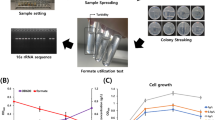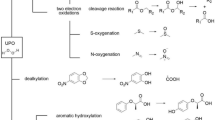Abstract
Acinetobacter baumannii harbours a gene cluster similar to the iac locus of Pseudomonas putida 1290, which can catabolize the plant hormone indole 3-acetic acid (IAA) as an energy source. However, there has been no evidence showing that IAA can be utilized by A. baumannii. This study showed that A. baumannii can grow in M9 minimal medium containing IAA as the sole carbon source. A mutagenesis study indicated that iacA, encoded in the iac locus of A. baumannii, is involved in the catabolism of IAA. As shown by western blotting analysis, the IacA protein was detected in A. baumannii grown in M9 minimal medium with IAA but not with pyruvate, suggesting that the expression of iacA is regulated by the presence of IAA. In vitro studies have shown that IacA can oxidize indole, an IAA-like molecule, converting it to indoxyl, which spontaneously dimerises to form indigo. In this study, we show that the crude extracts from either wild-type A. baumannii or Escherichia coli overexpressing IacA can oxidize IAA. These results imply that the iac gene cluster of A. baumannii is involved in IAA degradation and that the iacA gene is upregulated when cells encounter IAA in their native environments.




Similar content being viewed by others
References
Alemayehu D, Gordon LM, O’Mahony MM, O’Leary ND, Dobson AD (2004) Cloning and functional analysis by gene disruption of a novel gene involved in indigo production and fluoranthene metabolism in Pseudomonas alcaligenes PA-10. FEMS Microbiol Lett 239:285–293
Bateman A et al (2004) The Pfam protein families database. Nucleic Acids Res 32:D138–D141
Celik A, Speight RE, Turner NJ (2005) Identification of broad specificity P450CAM variants by primary screening against indole as substrate. Chem Commun (Camb) 29:3652–3654
Choi HS, Kim JK, Cho EH, Kim YC, Kim JI, Kim SW (2003) A novel flavin-containing monooxygenase from Methylophaga sp strain SK1 and its indigo synthesis in Escherichia coli. Biochem Biophys Res Commun 306:930–936
Choi KY, Kim D, Koh SC, So JS, Kim JS, Kim E (2004) Molecular cloning and identification of a novel oxygenase gene specifically induced during the growth of Rhodococcus sp. strain T104 on limonene. J Microbiol 42:160–162
Dorsey CW, Tomaras AP, Actis LA (2002) Genetic and phenotypic analysis of Acinetobacter baumannii insertion derivatives generated with a transposome system. Appl Environ Microbiol 68:6353–6360
Doukyu N, Toyoda K, Aono R (2003) Indigo production by Escherichia coli carrying the phenol hydroxylase gene from Acinetobacter sp. strain ST-550 in a water-organic solvent two-phase system. Appl Microbiol Biotechnol 60:720–725
Drewlo S, Bramer CO, Madkour M, Mayer F, Steinbuchel A (2001) Cloning and expression of a Ralstonia eutropha HF39 gene mediating indigo formation in Escherichia coli. Appl Environ Microbiol 67:1964–1969
Dym O, Eisenberg D (2001) Sequence-structure analysis of FAD-containing proteins. Protein Sci 10:1712–1728
Eisenbrand G, Hippe F, Jakobs S, Muehlbeyer S (2004) Molecular mechanisms of indirubin and its derivatives: novel anticancer molecules with their origin in traditional Chinese phytomedicine. J Cancer Res Clin Oncol 130:627–635
Ensley BD, Ratzkin BJ, Osslund TD, Simon MJ, Wackett LP, Gibson DT (1983) Expression of naphthalene oxidation genes in Escherichia coli results in the biosynthesis of indigo. Science 222:167–169
Finn RD et al (2006) Pfam: clans, web tools and services. Nucleic Acids Res 34:D247–D251
Furuya T, Takahashi S, Ishii Y, Kino K, Kirimura K (2004) Cloning of a gene encoding flavin reductase coupling with dibenzothiophene monooxygenase through coexpression screening using indigo production as selective indication. Biochem Biophys Res Commun 313:570–575
Gillam EM et al (1999) Formation of indigo by recombinant mammalian cytochrome P450. Biochem Biophys Res Commun 265:469–472
Gray PHH (1928) The formation of indigotin from indol by soil bacteria. Proc R Soc Lond Ser B 102:263–280
Hart S, Kirby R, Woods DR (1990) Structure of a Rhodococcus gene encoding pigment production in Escherichia coli. J Gen Microbiol 136:1357–1363
Hoessel R et al (1999) Indirubin, the active constituent of a Chinese antileukaemia medicine, inhibits cyclin-dependent kinases. Nat Cell Biol 1:60–67
Keil H, Saint CM, Williams PA (1987) Gene organization of the first catabolic operon of TOL plasmid pWW53: production of indigo by the xylA gene product. J Bacteriol 169:764–770
Kim JJ, Miura R (2004) Acyl-CoA dehydrogenases and acyl-CoA oxidases. Structural basis for mechanistic similarities and differences. Eur J Biochem 271:483–493
Kunikata T, Tatefuji T, Aga H, Iwaki K, Ikeda M, Kurimoto M (2000) Indirubin inhibits inflammatory reactions in delayed-type hypersensitivity. Eur J Pharmacol 410:93–100
Kwon NR et al (2008) Identification of functionally important amino acids in a novel indigo-producing oxygenase from Rhodococcus sp. strain T104. Appl Microbiol Biotechnol 79:417–422
Laemmli UK (1970) Cleavage of structural proteins during the assembly of the head of bacteriophage T4. Nature 227:680–685
Leclerc S et al (2001) Indirubins inhibit glycogen synthase kinase-3 beta and CDK5/p25, two protein kinases involved in abnormal tau phosphorylation in Alzheimer’s disease. A property common to most cyclin-dependent kinase inhibitors? J Biol Chem 276:251–260
Leveau JH, Gerards S (2008) Discovery of a bacterial gene cluster for catabolism of the plant hormone indole 3-acetic acid. FEMS Microbiol Ecol 65:238–250
Li QS, Schwaneberg U, Fischer P, Schmid RD (2000) Directed evolution of the fatty-acid hydroxylase P450 BM-3 into an indole-hydroxylating catalyst. Chemistry 6:1531–1536
Lim HK et al (2005) Characterization of a forest soil metagenome clone that confers indirubin and indigo production on Escherichia coli. Appl Environ Microbiol 71:7768–7777
Loehfelm TW, Luke NR, Campagnari AA (2008) Identification and characterization of an Acinetobacter baumannii biofilm-associated protein. J Bacteriol 190:1036–1044
Marko D et al (2001) Inhibition of cyclin-dependent kinase 1 (CDK1) by indirubin derivatives in human tumour cells. Br J Cancer 84:283–289
McClay K, Boss C, Keresztes I, Steffan RJ (2005) Mutations of toluene-4-monooxygenase that alter regiospecificity of indole oxidation and lead to production of novel indigoid pigments. Appl Environ Microbiol 71:5476–5483
Meyer A, Wursten M, Schmid A, Kohler HP, Witholt B (2002) Hydroxylation of indole by laboratory-evolved 2-hydroxybiphenyl 3-monooxygenase. J Biol Chem 277:34161–34167
Miller JH (1972) Experiments in molecular genetics. Cold Spring Harbor Laboratory, Cold Spring Harbor
Morgan DO (1997) Cyclin-dependent kinases: engines, clocks, and microprocessors. Annu Rev Cell Dev Biol 13:261–291
Murdock D, Ensley BD, Serdar C, Thalen M (1993) Construction of metabolic operons catalyzing the de novo biosynthesis of indigo in Escherichia coli. Biotechnology (NY) 11:381–386
Nakamura K, Martin MV, Guengerich FP (2001) Random mutagenesis of human cytochrome p450 2A6 and screening with indole oxidation products. Arch Biochem Biophys 395:25–31
O’Connor KE, Hartmans S (1998) Indigo formation by aromatic hydrocarbon-degrading bacteria. Biotechnol Lett 20:219–223
O’Connor KE, Dobson AD, Hartmans S (1997) Indigo formation by microorganisms expressing styrene monooxygenase activity. Appl Environ Microbiol 63:4287–4291
Olson SA (1994) MacVector: an integrated sequence analysis program for the Macintosh. Methods Mol Biol 25:195–201
Rosic NN (2009) Versatile capacity of shuffled cytochrome P450s for dye production. Appl Microbiol Biotechnol 82:203–210
Rosic NN, Huang W, Johnston WA, DeVoss JJ, Gillam EM (2007) Extending the diversity of cytochrome P450 enzymes by DNA family shuffling. Gene 395:40–48
Royo JL, Moreno-Ruiz E, Cebolla A, Santero E (2005) Stable long-term indigo production by overexpression of dioxygenase genes using a chromosomal integrated cascade expression circuit. J Biotechnol 116:113–124
Rui L, Reardon KF, Wood TK (2005) Protein engineering of toluene ortho-monooxygenase of Burkholderia cepacia G4 for regiospecific hydroxylation of indole to form various indigoid compounds. Appl Microbiol Biotechnol 66:422–429
Seixas de Melo J, Moura AP, Melo MJ (2004) Photophysical and spectroscopic studies of indigo derivatives in their keto and leuco forms. J Phys Chem A 108:6975–6981
Shu HY et al (2009) Genetic diversity of capsular polysaccharide biosynthesis in Klebsiella pneumoniae clinical isolates. Microbiology 155:4170–4183
Tischler D, Eulberg D, Lakner S, Kaschabek SR, van Berkel WJ, Schlomann M (2009) Identification of a novel self-sufficient styrene monooxygenase from Rhodococcus opacus 1CP. J Bacteriol 191:4996–5009
van den Heuvel S, Harlow E (1993) Distinct roles for cyclin-dependent kinases in cell cycle control. Science 262:2050–2054
van Hellemond EW, Janssen DB, Fraaije MW (2007) Discovery of a novel styrene monooxygenase originating from the metagenome. Appl Environ Microbiol 73:5832–5839
Weng YP, Hsu FC, Yang WS, Chen HP (2006) Optimization of the overexpression of glutamate mutase S component under the control of T7 system by using lactose and IPTG as the inducers. Enzyme Microb Technol 38:465–469
Wu ZL, Aryal P, Lozach O, Meijer L, Guengerich FP (2005) Biosynthesis of new indigoid inhibitors of protein kinases using recombinant cytochrome P450 2A6. Chem Biodivers 2:51–65
Wu KM et al (2009) Genome sequencing and comparative analysis of Klebsiella pneumoniae NTUH-K2044, a strain causing liver abscess and meningitis. J Bacteriol 191:4492–4501
Yanofsky C, Horn V (1981) Rifampin resistance mutations that alter the efficiency of transcription termination at the tryptophan operon attenuator. J Bacteriol 145:1334–1341
Zhang ZG, Liu Y, Guengerich FP, Matse JH, Chen J, Wu ZL (2009) Identification of amino acid residues involved in 4-chloroindole 3-hydroxylation by cytochrome P450 2A6 using screening of random libraries. J Biotechnol 139:12–18
Acknowledgments
The authors acknowledge the technical services provided by Sequencing Core Facility of the National Yang-Ming University Genome Research Center (YMGC). The Sequencing Core Facility is supported by National Research Program for Genomic Medicine (NRPGM), National Science Council. This project was supported by National Science Counsel of Taiwan (NSC97-2320-B-309-001 and NSC98-2320-B-309-003-MY3). This study was also supported in part by Tzu Chi University under contract number TCMRC-P-99011.
Author information
Authors and Affiliations
Corresponding author
Rights and permissions
About this article
Cite this article
Lin, GH., Chen, HP., Huang, JH. et al. Identification and characterization of an indigo-producing oxygenase involved in indole 3-acetic acid utilization by Acinetobacter baumannii . Antonie van Leeuwenhoek 101, 881–890 (2012). https://doi.org/10.1007/s10482-012-9704-4
Received:
Accepted:
Published:
Issue Date:
DOI: https://doi.org/10.1007/s10482-012-9704-4




